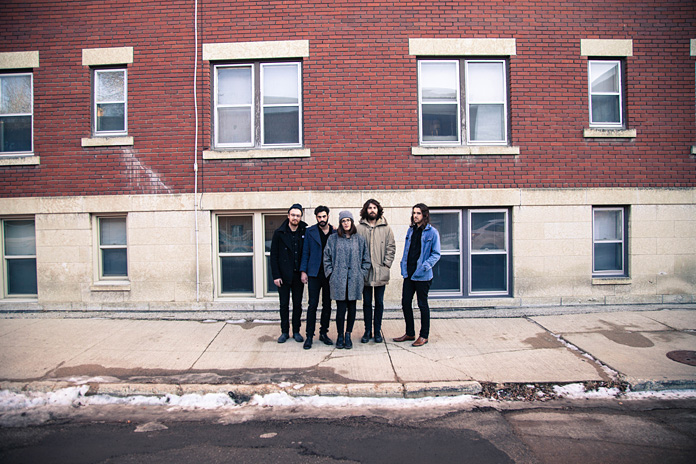
Living Hour
Hunkered Down Dream Pop
May 26, 2016
Living Hour
![]()
Gil Carroll didn’t set out to make one of 2016’s most buzzed-about dream pop records. Yet he and the other members of Living Hour seem to have done just that, despite the fact that he adamantly says, “When we started this band, I didn’t even know what the term ‘dream pop’ meant.”
The Winnipeg, Canada foursome are, by this point, huge fans of that subdued, atmospheric niche of indie rock. However Carroll, the band’s guitarist, says there is so much more to Living Hour than that. For instance, Carroll points to singer and frontwoman Sam Sarty, who also plays trombone on the band’s self-titled debut. Sarty’s trombone “adds this new unique element to the music,” Carroll says. “If you saw us live now, you wouldn’t immediately say it’s dream pop. We also have these bright guitar harmony parts, which are not an in-your-face dream pop sound, but more diverse.”
That eclecticism has been integral to the band since the beginning. Before Carroll, fellow guitarist and backup vocalist Adam Soloway, drummer Alex Chochinov, and Sarty formed Living Hour. Carroll heard that Sarty had a YouTube channel where she covered classics by Elvis Presley and The Cure. “She doesn’t have it anymore, but before she deleted the videos I saw them and discovered she had an amazing voice.”
As fellow students at the relatively small University of Winnipeg in Western Canada in 2012, Carroll and Sarty had already heard about each other and crossed paths on a few occasions. And while Carroll was impressed with her reinterpretation of acts as disparate as Elvis and The Cure, Sarty in fact had a much narrower musical upbringing.
“I was born with long fingers, so the nurse told my mom to put me in piano lessons,” she says, adding that although she thoroughly enjoyed her first few years of playing, her teacher eventually placed a greater focus on theory that proved to be off-putting. “I didn’t want to do exams, I wanted to play things that made me feel good. So I started guitar.”
However, Sarty’s more rigorous training eventually came in handy when she joined Living Hour, giving her the discipline to experiment with her vocal range and play trombone during recording sessions. She now revels in such challenges, especially because they help her hunker down and endure Winnipeg’s raw prairie winters that last half the year. “A lot of the time that’s where the creativity is fostered, to avoid cabin fever,” she says.
Carroll agrees that there are benefits to the city’s frozen isolation. “Winnipeg currently has a great scene with tons of good bands. But it’s definitely a small scene. So it’s not difficult to get good opportunities for playing shows and meeting like-minded people.”
And while it was easy to find like artists around town, Sarty’s parents had a very different attitude about her dedication to Living Hour. She says most of her relatives serve in the Canadian military and are far from being creative types. “My dad can’t even clap,” she laughs.
“I got quite a few emails from my mom with some job applications attached, which I ignored,” Sarty adds of the period when Living Hour first began to play, record, and tour seriously. However, her family slowly began to admire her devotion to the project. “They came around and are now supportive. My family is dispersed across the continent, because they’re officers assigned to different bases. So they actually like that I travel with my work. They actually like that I’m on tour.”
[Note: This article originally appeared in Under the Radar’s May/June 2016 Issue, which is out now. This is its debut online.]
Current Issue

Issue #72
Apr 19, 2024 Issue #72 - The ‘90s Issue with The Cardigans and Thurston Moore
Most Recent
- Under the Radar Announces The ’90s Issue with The Cardigans and Thurston Moore on the Covers (News) — The Cardigans, Thurston Moore, Sonic Youth, Garbage, The Cranberries, Pavement, Lisa Loeb, Supergrass, Spiritualized, Lush, Miki Berenyi, Miki Berenyi Trio, Emma Anderson, Hatchie, Ride, Slowdive, Velocity Girl, Penelope Spheeris, Terry Gilliam, Gus Van Sant, Ron Underwood, Kula Shaker, Salad, Foals, Semisonic, The Boo Radleys, Stereo MC’s, Pale Saints, Blonde Redhead, Sleater-Kinney, Cocteau Twins, Lucy Dacus, Alex Lahey, Horsegirl, Grandaddy, alt-J, Squid, The Natvral, Wolf Alice, Jess Williamson, Sunflower Bean, Orville Peck, Joel McHale
- 10 Best Songs of the Week: Fontaines D.C., Cassandra Jenkins, Loma, John Grant, and More (News) — Songs of the Week, Fontaines D.C., Cassandra Jenkins, Loma, John Grant, Good Looks, Hana Vu, Belle and Sebastian, Yannis & The Yaw, Strand of Oaks, Home Counties
- Fresh Shares New EP ‘Merch Girl’ (News) — Fresh
- Premiere: LOVECOLOR Shares New Video for “Crazy Love” (News) — LOVECOLOR
- Final Summer (Review) — Cloud Nothings

Comments
Submit your comment
There are no comments for this entry yet.